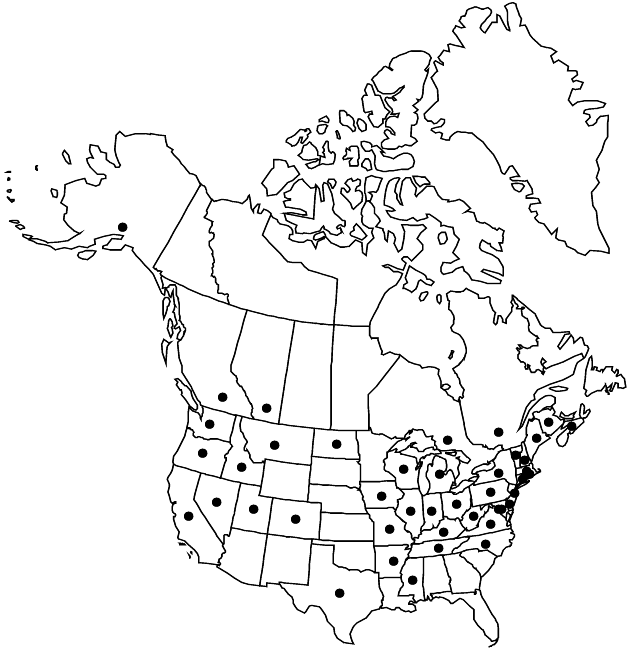Difference between revisions of "Crepis capillaris"
Linnaea 14: 657. 1840.
FNA>Volume Importer |
imported>Volume Importer |
||
| (2 intermediate revisions by 2 users not shown) | |||
| Line 8: | Line 8: | ||
}} | }} | ||
|common_names=Smooth hawksbeard;crépis capillaire | |common_names=Smooth hawksbeard;crépis capillaire | ||
| + | |special_status={{Treatment/ID/Special_status | ||
| + | |code=I | ||
| + | |label=Introduced | ||
| + | }} | ||
|basionyms={{Treatment/ID/Basionym | |basionyms={{Treatment/ID/Basionym | ||
|name=Lapsana capillaris | |name=Lapsana capillaris | ||
| Line 38: | Line 42: | ||
|elevation=0–1300 m | |elevation=0–1300 m | ||
|distribution=Alta.;B.C.;N.B.;N.S.;Ont.;Que.;Alaska;Ark.;Calif.;Colo.;Conn.;Del.;D.C.;Idaho;Ill.;Ind.;Iowa;Ky.;Maine;Md.;Mass.;Mich.;Miss.;Mo.;Mont.;Nev.;N.H.;N.J.;N.Y.;N.C.;N.Dak.;Ohio;Oreg.;Pa.;R.I.;Tenn.;Tex.;Utah;Vt.;Va.;Wash.;W.Va.;Wis.;Europe. | |distribution=Alta.;B.C.;N.B.;N.S.;Ont.;Que.;Alaska;Ark.;Calif.;Colo.;Conn.;Del.;D.C.;Idaho;Ill.;Ind.;Iowa;Ky.;Maine;Md.;Mass.;Mich.;Miss.;Mo.;Mont.;Nev.;N.H.;N.J.;N.Y.;N.C.;N.Dak.;Ohio;Oreg.;Pa.;R.I.;Tenn.;Tex.;Utah;Vt.;Va.;Wash.;W.Va.;Wis.;Europe. | ||
| + | |introduced=true | ||
|discussion=<p><i>Crepis capillaris</i> is recognized by its shallow root system, dense rosettes of coarsely dentate or pinnately lobed leaves, erect slender stems, auriculate-based cauline leaves, relatively small heads, phyllaries with double rows of black setae, and fluffy white pappi. It is weedy and can become a serious lawn pest. It is one of only three species of <i>Crepis</i> with 2n = 6; E. B. Babcock (1947) considered it to be advanced in the genus.</p> | |discussion=<p><i>Crepis capillaris</i> is recognized by its shallow root system, dense rosettes of coarsely dentate or pinnately lobed leaves, erect slender stems, auriculate-based cauline leaves, relatively small heads, phyllaries with double rows of black setae, and fluffy white pappi. It is weedy and can become a serious lawn pest. It is one of only three species of <i>Crepis</i> with 2n = 6; E. B. Babcock (1947) considered it to be advanced in the genus.</p> | ||
|tables= | |tables= | ||
| Line 61: | Line 66: | ||
|publication title=Linnaea | |publication title=Linnaea | ||
|publication year=1840 | |publication year=1840 | ||
| − | |special status= | + | |special status=Introduced |
| − | |source xml=https:// | + | |source xml=https://bitbucket.org/aafc-mbb/fna-data-curation/src/2e0870ddd59836b60bcf96646a41e87ea5a5943a/coarse_grained_fna_xml/V19-20-21/V19_284.xml |
|tribe=Asteraceae tribe Cichorieae | |tribe=Asteraceae tribe Cichorieae | ||
|genus=Crepis | |genus=Crepis | ||
Latest revision as of 19:50, 5 November 2020
Annuals or biennials, 10–90 cm (taproots shallow). Stems 1(–6+), erect to ± procumbent, usually simple (usually with single stout leader, sometimes multiple with slender laterals), hispid proximally or throughout. Leaves: basal and cauline; petiolate (petiole bases clasping); blades lanceolate or oblanceolate, runcinate or lyrate, 5–30 × 1–4.5 cm, margins pinnately divided to sharply dentate (lobes remote, unequal), apices obtuse or acute, mucronate, faces glabrous or sparsely hispid (hairs yellow; proximal cauline auriculate and clasping). Heads 10–15(–30+), in corymbiform arrays. Calyculi of 8, linear, tomentulose or stipitate-glandular bractlets 2–4 mm. Involucres cylindric to turbinate, 5–8 × 3–6 mm. Phyllaries 8–16, lanceolate, 6–7 mm (margins scarious), apices acute, abaxial faces stipitate-glandular and glandular setose (setae black, usually in 2 rows), adaxial glabrous. Florets 20–60; corollas deep yellow (reddish abaxially), 8–12 mm (hairy). Cypselae brownish yellow, fusiform, 1.5–2.5 mm, apices narrowed (not beaked), ribs 10 (glabrous or scabrous); pappi white (fluffy), 3–4 mm (scarcely surpassing phyllaries). 2n = 6.
Phenology: Flowering May–Nov.
Habitat: Meadows, pastures, lawns, roadsides, fields, waste places
Elevation: 0–1300 m
Distribution

Introduced; Alta., B.C., N.B., N.S., Ont., Que., Alaska, Ark., Calif., Colo., Conn., Del., D.C., Idaho, Ill., Ind., Iowa, Ky., Maine, Md., Mass., Mich., Miss., Mo., Mont., Nev., N.H., N.J., N.Y., N.C., N.Dak., Ohio, Oreg., Pa., R.I., Tenn., Tex., Utah, Vt., Va., Wash., W.Va., Wis., Europe.
Discussion
Crepis capillaris is recognized by its shallow root system, dense rosettes of coarsely dentate or pinnately lobed leaves, erect slender stems, auriculate-based cauline leaves, relatively small heads, phyllaries with double rows of black setae, and fluffy white pappi. It is weedy and can become a serious lawn pest. It is one of only three species of Crepis with 2n = 6; E. B. Babcock (1947) considered it to be advanced in the genus.
Selected References
None.